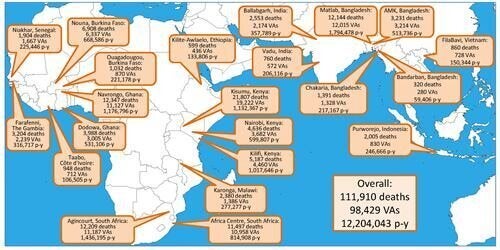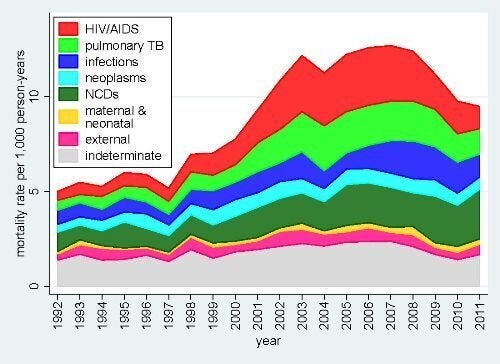Today a landmark dataset on causes of death in Africa and Asia is published by the INDEPTH Network. Over 110,000 deaths have been tracked and followed up in 22 population surveillance sites in Africa and Asia. Interviews were carried out with families or witnesses of the death (a process known as verbal autopsy ) and the results computer processed in a standard way. All the details are available for free download. Here's a map showing all the sites involved.

Why is this important? Normally the majority of deaths in Africa and Asia are not recorded at all. Up to now, most figures have relied on elaborate estimates, made because of the lack of real data. This is a major problem for planning good health services - if you don't know why people are dying, it's hard to target the treatments and services that are needed for those still living. This study is also an important stepping stone towards registering deaths and their causes on a routine basis.
What are the important findings? Causes of death vary hugely across Africa and Asia. In Asia, mortality rates have fallen in many places as infectious diseases have come under control. Non-communicable diseases (like heart disease, diabetes, cancers) are still fairly low too, but risk factors (like fast food, smoking and alcohol) are increasing. Also more people are living into the age groups where non-communicable diseases become more common, so mortality rates will undoubtedly increase. Fortunately most of Asia has not been heavily affected by HIV/AIDS, which has had a major effect on causes of death in Africa. One site in South Africa has tracked causes of death during the 20 years of the HIV/AIDS epidemic, as shown in the chart.

At least now a clear decrease in HIV/AIDS is evident. Malaria also continues to be a major problem in parts of Africa. There are signs of progress, but the disease still kills large numbers of African children.
Diseases though are not the only hazards. Accidents, violence and suicide all take their toll. This partly relates to environmental conditions (for example, many children drowned in Bangladesh, where there are so many rivers and lakes). In western Africa, where road infrastructure is generally poor, there were large numbers of fatal traffic accidents. Pregnancy and childbirth - which is hopefully a natural and positive process - turns out to be a major danger for many mothers and their newborn children. Huge investment is still needed across Africa and Asia to bring facilities and services for maternity care up to acceptable standards.
Documenting deaths brings no consolation to those who have died, perhaps unnecessarily. But mortality statistics are a critical, and sometimes unappreciated, building block for good health services. This new material from INDEPTH provides much needed data on causes of death, and also proves that we have the methods for registering deaths and their causes, which could and should be applied much more widely.
